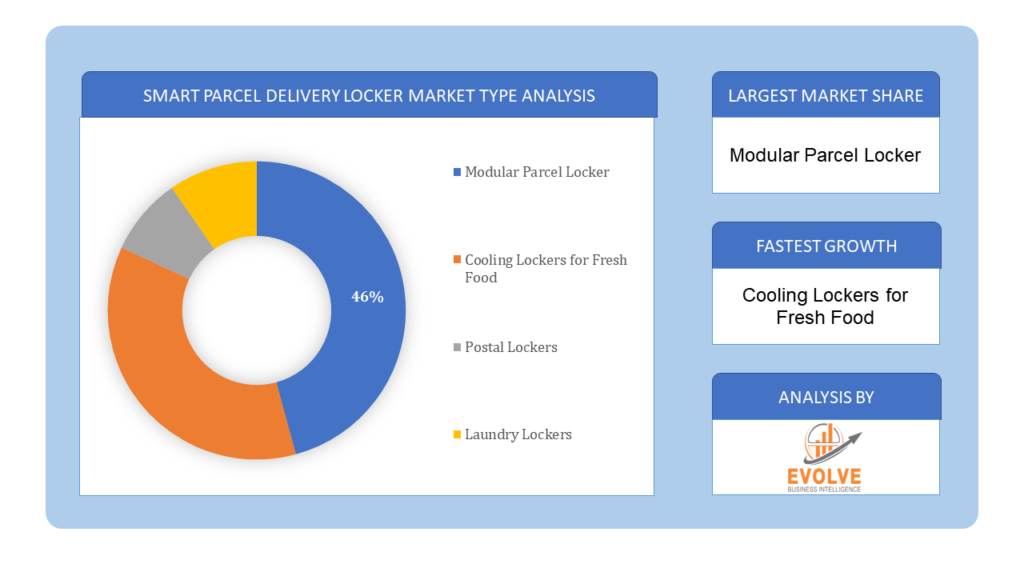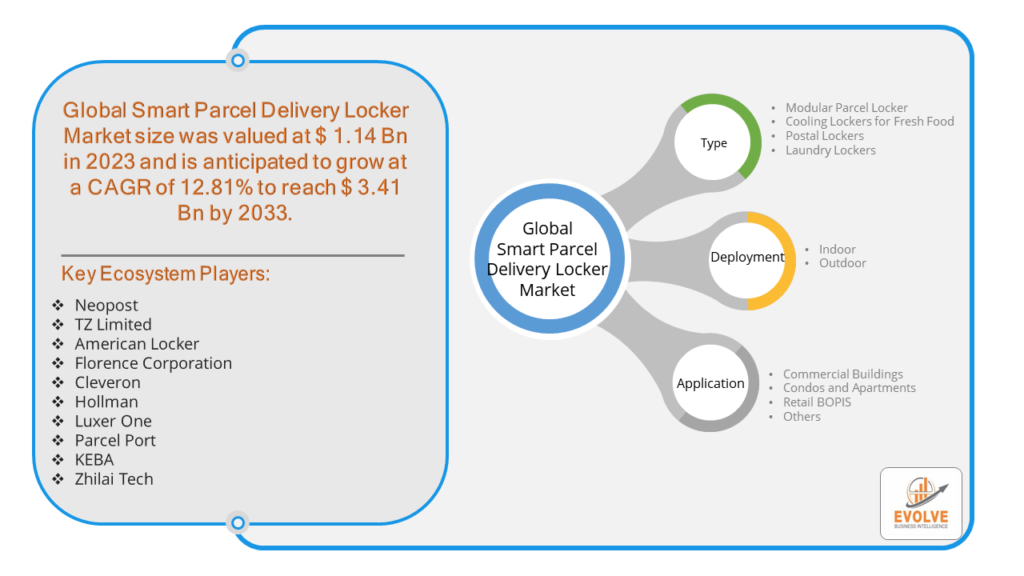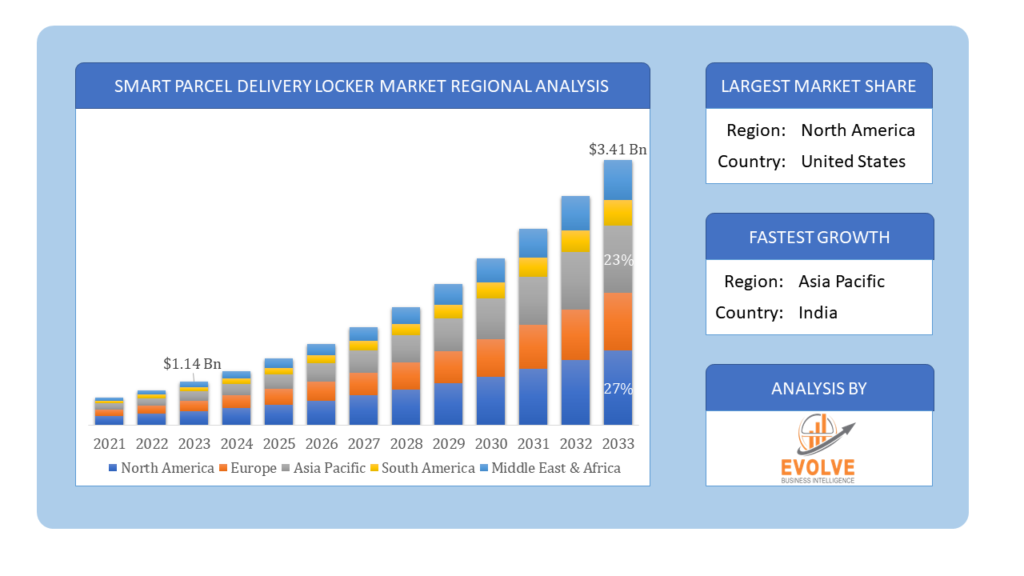Smart Parcel Delivery Locker Market Analysis and Global Forecast 2023-2033
$1,898.24 – $7,538.33Price range: $1,898.24 through $7,538.33
Smart Parcel Delivery Locker Market Research Report: Information By Type (Modular Parcel Locker, Cooling Lockers for Fresh Food, Postal Lockers, Laundry Lockers), By Application (Commercial Buildings, Condos and Apartments, Retail BOPIS, Others), By Deployment (Indoor, Outdoor), and by Region — Forecast till 2033
Page: 158
Smart Parcel Delivery Locker Market Overview
The Smart Parcel Delivery Locker Market Size is expected to reach USD 3.41 Billion by 2033. The Smart Parcel Delivery Locker Market industry size accounted for USD 1.14 Billion in 2023 and is expected to expand at a compound annual growth rate (CAGR) of 12.81% from 2023 to 2033. A Smart Parcel Delivery Locker is an automated, secure storage system designed for the delivery, storage, and retrieval of packages. These lockers are equipped with advanced technologies such as internet connectivity, sensors, and electronic locks, and are often integrated with software platforms that allow users to access their parcels using a unique code, smartphone app, or biometric verification. Located in various convenient locations like residential complexes, office buildings, retail stores, and public areas, smart parcel delivery lockers provide a contactless and efficient solution for parcel management, minimizing missed deliveries and improving overall logistics efficiency.
Global Smart Parcel Delivery Locker Market Synopsis
The COVID-19 pandemic had several impacts on the Smart Parcel Delivery Locker Market. The surge in online shopping and e-commerce due to lockdowns and social distancing measures significantly increased the demand for contactless delivery solutions, including smart parcel delivery lockers. These lockers provided a safe and convenient option for parcel collection, reducing human interaction and enhancing delivery efficiency. Additionally, the need for secure and efficient last-mile delivery solutions became more pronounced, further driving the adoption of smart lockers in residential complexes, retail locations, and public areas. However, the pandemic also posed challenges such as supply chain disruptions and delays in the installation and deployment of new locker systems.
Smart Parcel Delivery Locker Market Dynamics
The major factors that have impacted the growth of the Smart Parcel Delivery Locker Market are as follows:
Drivers:
Ø Surge in E-commerce and Online Shopping
The rapid growth of e-commerce and online shopping has significantly increased the volume of parcel deliveries, driving the demand for efficient and secure delivery solutions such as smart parcel delivery lockers. These lockers provide a convenient, contactless way to receive packages, accommodating the higher delivery volumes and enhancing the customer experience.
Restraint:
- High Installation and Maintenance Costs
The initial investment required for installing smart parcel delivery lockers and the ongoing maintenance costs can be substantial. This financial burden can be a significant restraint for small businesses and residential complexes, limiting the widespread adoption of these systems.
Opportunity:
⮚ Technological Advancements and Integration
Advances in technology, such as improved IoT connectivity, AI-driven logistics, and enhanced security features, present significant opportunities for the smart parcel delivery locker market. These innovations can enhance the functionality and efficiency of smart lockers, making them more attractive to a broader range of users and facilitating integration with other smart city initiatives and e-commerce platforms.
Smart Parcel Delivery Locker Market Segment Overview
By Type
 Based on Type, the market is segmented based on Modular Parcel Locker, Cooling Lockers for Fresh Food, Postal Lockers, and Laundry Lockers. The Modular Parcel Locker segment dominated the Smart Parcel Delivery Locker Market due to its flexibility and scalability, allowing for customized configurations to meet varying space and capacity requirements. This adaptability makes modular lockers suitable for a wide range of locations, from residential complexes to retail centers, enhancing their widespread adoption and market dominance.
Based on Type, the market is segmented based on Modular Parcel Locker, Cooling Lockers for Fresh Food, Postal Lockers, and Laundry Lockers. The Modular Parcel Locker segment dominated the Smart Parcel Delivery Locker Market due to its flexibility and scalability, allowing for customized configurations to meet varying space and capacity requirements. This adaptability makes modular lockers suitable for a wide range of locations, from residential complexes to retail centers, enhancing their widespread adoption and market dominance.
By Deployment
Based on Deployment, the market segment has been divided into the Indoor and Outdoor. The Indoor segment dominated the Smart Parcel Delivery Locker Market due to its suitability for secure and controlled environments, such as residential buildings, office complexes, and retail stores. Indoor lockers offer enhanced security and protection from weather conditions, making them a preferred choice for efficient parcel management.
By Application
Based on Application, the market segment has been divided into Commercial Buildings, Condos and Apartments, Retail BOPIS, and Others. The Commercial Buildings segment dominated the Smart Parcel Delivery Locker Market due to the high demand for efficient parcel management solutions in office complexes and retail centers. These lockers help streamline package deliveries and collections, catering to the needs of businesses and their employees, enhancing convenience and security.
Global Smart Parcel Delivery Locker Market Regional Analysis
Based on region, the global Smart Parcel Delivery Locker Market has been divided into North America, Europe, Asia-Pacific, the Middle East & Africa, and Latin America. North America is projected to dominate the use of the Smart Parcel Delivery Locker Market followed by the Asia-Pacific and Europe regions.
 Smart Parcel Delivery Locker North America Market
Smart Parcel Delivery Locker North America Market
North America holds a dominant position in the Smart Parcel Delivery Locker Market due to the region’s advanced e-commerce industry, high adoption rate of innovative technologies, and well-established logistics infrastructure. Additionally, the increasing demand for contactless delivery solutions and efficient parcel management systems in residential and commercial buildings further drives the market’s growth in this region.
Smart Parcel Delivery Locker Asia-Pacific Market
The Asia-Pacific region has indeed emerged as the fastest-growing market for the Smart Parcel Delivery Locker industry. This growth is driven by the rapid expansion of e-commerce, urbanization trends, and increasing adoption of smart city initiatives across countries like China, Japan, India, and Southeast Asian nations. The demand for convenient and secure parcel delivery solutions in densely populated urban areas is fueling the deployment of smart parcel lockers in residential complexes, office buildings, and retail spaces. Moreover, advancements in technology and rising consumer expectations for efficient logistics solutions are further accelerating the growth of the market in the Asia-Pacific region.
Competitive Landscape
The global Smart Parcel Delivery Locker Market is highly competitive, with numerous players offering a wide range of software solutions. The competitive landscape is characterized by the presence of established companies, as well as emerging startups and niche players. To increase their market position and attract a wide consumer base, the businesses are employing various strategies, such as Product launches, and strategic alliances.
Prominent Players:
- Neopost
- TZ Limited
- American Locker
- Florence Corporation
- Cleveron
- Hollman
- Luxer One
- Parcel Port
- KEBA
- Zhilai Tech
Scope of the Report
Global Smart Parcel Delivery Locker Market, by Type
- Modular Parcel Locker
- Cooling Lockers for Fresh Food
- Postal Lockers
- Laundry Lockers
Global Smart Parcel Delivery Locker Market, by Application
- Commercial Buildings
- Condos and Apartments
- Retail BOPIS
- Others
Global Smart Parcel Delivery Locker Market, by Deployment
- Indoor
- Outdoor
Global Smart Parcel Delivery Locker Market, by Region
- North America
- US
- Canada
- Mexico
- Europe
- UK
- Germany
- France
- Italy
- Spain
- Benelux
- Nordic
- Rest of Europe
- Asia Pacific
- China
- Japan
- South Korea
- Indonesia
- Austalia
- Malaysia
- India
- Rest of Asia Pacific
- South America
- Brazil
- Argentina
- Rest of South America
- Middle East & Africa
- Saudi Arabia
- UAE
- Egypt
- South Africa
- Rest of Middle East & Africa
| Parameters | Indicators |
|---|---|
| Market Size | 2033: $3.41 Billion/strong> |
| CAGR | 12.81% CAGR (2023-2033) |
| Base year | 2022 |
| Forecast Period | 2023-2033 |
| Historical Data | 2021 |
| Report Coverage | Revenue Forecast, Competitive Landscape, Growth Factors, and Trends |
| Key Segmentations | Type, Deployment, Application |
| Geographies Covered | North America, Europe, Asia-Pacific, Latin America, Middle East, Africa |
| Key Vendors | Neopost, TZ Limited, American Locker, Florence Corporation, Cleveron, Hollman, Luxer One, Parcel Port, KEBA, Zhilai Tech |
| Key Market Opportunities | • Technological Advancements • Government initiatives to improve urban infrastructure |
| Key Market Drivers | • Increasing online shopping activities • The growth of urban areas increases the need for convenient parcel management solutions |
REPORT CONTENT BRIEF:
- High-level analysis of the current and future Smart Parcel Delivery Locker Market trends and opportunities
- Detailed analysis of current market drivers, restraining factors, and opportunities in the future
- Smart Parcel Delivery Locker Market historical market size for the year 2021, and forecast from 2023 to 2033
- Smart Parcel Delivery Locker Market share analysis at each Product level
- Competitor analysis with detailed insight into its Product segment, Government & Defense strength, and strategies adopted.
- Identifies key strategies adopted including Product launches and developments, mergers and acquisitions, joint ventures, collaborations, and partnerships as well as funding taken and investment done, among others.
- To identify and understand the various factors involved in the global Smart Parcel Delivery Locker Market affected by the pandemic
- To provide a detailed insight into the major companies operating in the market. The profiling will include the Government & Defense health of the company’s past 2-3 years with segmental and regional revenue breakup, Product offering, recent developments, SWOT analysis, and key strategies.
Press Release

Global Pharmaceutical Manufacturing Market to Reach $1.38 Trillion by 2035 with 7.35% CAGR, New Research Shows

The Global Mammography Market Is Estimated To Record a CAGR of Around 10.29% During The Forecast Period

Glue Stick Market to Reach USD 2.35 Billion by 2034

Podiatry Service Market to Reach USD 11.88 Billion by 2034

Microfluidics Technology Market to Reach USD 32.58 Billion by 2034

Ferric Chloride Market to Reach USD 10.65 Billion by 2034

Family Practice EMR Software Market to Reach USD 21.52 Billion by 2034

Electric Hairbrush Market to Reach USD 15.95 Billion by 2034

Daily Bamboo Products Market to Reach USD 143.52 Billion by 2034

Cross-border E-commerce Logistics Market to Reach USD 112.65 Billion by 2034
Frequently Asked Questions (FAQ)
1.What is the study period of this market?
- The study period of the global Smart Parcel Delivery Locker Market is 2021- 2033
2.What is the growth rate of the global Smart Parcel Delivery Locker Market?
- The global Smart Parcel Delivery Locker Market is growing at a CAGR of 12.81% over the next 10 years
3.Which region has the highest growth rate in the market of Smart Parcel Delivery Locker Market?
- Asia Pacific is expected to register the highest CAGR during 2023-2033
4.Which region has the largest share of the global Smart Parcel Delivery Locker Market?
- North America holds the largest share in 2022
5.Who are the key players in the global Smart Parcel Delivery Locker Market?
- Neopost, TZ Limited, American Locker, Florence Corporation, Cleveron, Hollman, Luxer One, Parcel Port, KEBA, and Zhilai Tech are the major companies operating in the market.
Table of Content
CHAPTER 1. Executive Summary CHAPTER 2. Scope of the Study 2.1. Market Definition 2.2. Market Scope & Segmentation 2.2.1. Objective of Report CHAPTER 3. Evolve BI Methodology 3.1. Data Collection & Validation Approach 3.2. Market Size Estimation and Forecast CHAPTER 4. Exclusive Analysis 4.1. Market Opportunity Score 4.1.1. Type Segement – Market Opportunity Score 4.1.2. Deployment Segment – Market Opportunity Score 4.1.3. Application Segment – Market Opportunity Score 4.2. Key Market Influencing Indicators CHAPTER 5. Market Insights and Trends 5.1. Value Chain Analysis 5.1.1. Raw Material 5.1.2. Manufacturing Process 5.1.3. Distribution Channel 5.1.4. End User 5.2. Porter’s Five Forces Analysis 5.2.1. Bargaining Power of Buyers 5.2.2. Bargaining Power of Suppliers 5.2.3. Threat of New Entrant 5.2.4. Threat of Substitute 5.2.5. Industry Rivalry 5.3. COVID-19 Impact and Post COVID Scenario on Smart Parcel Delivery Locker Market 5.3.1. Impact of COVID-19 5.3.2. Government Support and Industry Revival Policies 5.3.3. Measures Taken by Companies to Mitigate Negative Impact 5.3.4. Post COVID Trend CHAPTER 6. MArket Dynamics 6.1. Introduction 6.2. Drivers 6.2.1. Driver 1 6.2.2. Driver 2 6.2.3. Driver 3 6.3. Restraints 6.3.1. Restraint 1 6.3.2. Restraint 2 6.4. Opportunity 6.4.1. Opportunity 1 CHAPTER 7. Smart Parcel Delivery Locker Market, By Type 7.1. Introduction 7.1.1. Modular Parcel Locker 7.1.2. Cooling Lockers for Fresh Food 7.1.3 Postal Lockers 7.1.4 Laundry Lockers CHAPTER 8. Smart Parcel Delivery Locker Market, By Deployment 8.1. Introduction 8.1.1. Indoor 8.1.2. Outdoor CHAPTER 9. Smart Parcel Delivery Locker Market, By Application 9.1. Introduction 9.1.1. Commercial Buildings 9.1.2 Condos and Apartments 9.1.3 Retail BOPIS 9.1.4 Others CHAPTER 10. Smart Parcel Delivery Locker Market, By Region 10.1. Introduction 10.2. NORTH AMERICA 10.2.1. North America: Market Size and Forecast, By Country, 2023 – 2033 ($ Million) 10.2.2. North America: Market Size and Forecast, By Type, 2023 – 2033 ($ Million) 10.2.3. North America: Market Size and Forecast, By Deployment, 2023 – 2033 ($ Million) 10.2.4. North America: Market Size and Forecast, By Application, 2023 – 2033 ($ Million) 10.2.5. US 10.2.5.1. US: Market Size and Forecast, By Type, 2023 – 2033 ($ Million) 10.2.5.2. US: Market Size and Forecast, By Deployment, 2023 – 2033 ($ Million) 10.2.5.3. US: Market Size and Forecast, By Application, 2023 – 2033 ($ Million) 10.2.6. CANADA 10.2.6.1. Canada: Market Size and Forecast, By Type, 2023 – 2033 ($ Million) 10.2.6.2. Canada: Market Size and Forecast, By Deployment, 2023 – 2033 ($ Million) 10.2.6.3. Canada: Market Size and Forecast, By Application, 2023 – 2033 ($ Million) 10.2.7. MEXICO 10.2.7.1. Mexico: Market Size and Forecast, By Type, 2023 – 2033 ($ Million) 10.2.7.2. Mexico: Market Size and Forecast, By Deployment, 2023 – 2033 ($ Million) 10.2.7.3. Mexico: Market Size and Forecast, By Application, 2023 – 2033 ($ Million) 10.3. Europe 10.3.1. Europe: Market Size and Forecast, By Country, 2023 – 2033 ($ Million) 10.3.2. Europe: Market Size and Forecast, By Type, 2023 – 2033 ($ Million) 10.3.3. Europe: Market Size and Forecast, By Deployment, 2023 – 2033 ($ Million) 10.3.4. Europe: Market Size and Forecast, By Application, 2023 – 2033 ($ Million) 10.3.5. U.K. 10.3.5.1. U.K.: Market Size and Forecast, By Type, 2023 – 2033 ($ Million) 10.3.5.2. U.K.: Market Size and Forecast, By Deployment, 2023 – 2033 ($ Million) 10.3.5.3. U.K.: Market Size and Forecast, By Application, 2023 – 2033 ($ Million) 10.3.6. GERMANY 10.3.6.1. Germany: Market Size and Forecast, By Type, 2023 – 2033 ($ Million) 10.3.6.2. Germany: Market Size and Forecast, By Deployment, 2023 – 2033 ($ Million) 10.3.6.3. Germany: Market Size and Forecast, By Application, 2023 – 2033 ($ Million) 10.3.7. FRANCE 10.3.7.1. France: Market Size and Forecast, By Type, 2023 – 2033 ($ Million) 10.3.7.2. France: Market Size and Forecast, By Deployment, 2023 – 2033 ($ Million) 10.3.7.3. France: Market Size and Forecast, By Application, 2023 – 2033 ($ Million) 10.3.8. ITALY 10.3.8.1. Italy: Market Size and Forecast, By Type, 2023 – 2033 ($ Million) 10.3.8.2. Italy: Market Size and Forecast, By Deployment, 2023 – 2033 ($ Million) 10.3.8.3. Italy: Market Size and Forecast, By Application, 2023 – 2033 ($ Million) 10.3.9. SPAIN 10.3.9.1. Spain: Market Size and Forecast, By Type, 2023 – 2033 ($ Million) 10.3.9.2. Spain: Market Size and Forecast, By Deployment, 2023 – 2033 ($ Million) 10.3.9.3. Spain: Market Size and Forecast, By Application, 2023 – 2033 ($ Million) 10.3.10. BENELUX 10.3.10.1. BeNeLux: Market Size and Forecast, By Type, 2023 – 2033 ($ Million) 10.3.10.2. BeNeLux: Market Size and Forecast, By Deployment, 2023 – 2033 ($ Million) 10.3.10.3. BeNeLux: Market Size and Forecast, By Application, 2023 – 2033 ($ Million) 10.3.11. RUSSIA 10.3.11.1. Russia: Market Size and Forecast, By Type, 2023 – 2033 ($ Million) 10.3.11.2. Russia: Market Size and Forecast, By Deployment, 2023 – 2033 ($ Million) 10.3.11.3. Russia: Market Size and Forecast, By Application, 2023 – 2033 ($ Million) 10.3.12. REST OF EUROPE 10.3.12.1. Rest of Europe: Market Size and Forecast, By Type, 2023 – 2033 ($ Million) 10.3.12.2. Rest of Europe: Market Size and Forecast, By Deployment, 2023 – 2033 ($ Million) 10.3.12.3. Rest of Europe: Market Size and Forecast, By Application, 2023 – 2033 ($ Million) 10.4. Asia Pacific 10.4.1. Asia Pacific: Market Size and Forecast, By Country, 2023 – 2033 ($ Million) 10.4.2. Asia Pacific: Market Size and Forecast, By Type, 2023 – 2033 ($ Million) 10.4.3. Asia Pacific: Market Size and Forecast, By Deployment, 2023 – 2033 ($ Million) 10.4.4. Asia Pacific: Market Size and Forecast, By Application, 2023 – 2033 ($ Million) 10.4.5. CHINA 10.4.5.1. China: Market Size and Forecast, By Type, 2023 – 2033 ($ Million) 10.4.5.2. China: Market Size and Forecast, By Deployment, 2023 – 2033 ($ Million) 10.4.5.3. China: Market Size and Forecast, By Application, 2023 – 2033 ($ Million) 10.4.6. JAPAN 10.4.6.1. Japan: Market Size and Forecast, By Type, 2023 – 2033 ($ Million) 10.4.6.2. Japan: Market Size and Forecast, By Deployment, 2023 – 2033 ($ Million) 10.4.6.3. Japan: Market Size and Forecast, By Application, 2023 – 2033 ($ Million) 10.4.7. INDIA 10.4.7.1. India: Market Size and Forecast, By Type, 2023 – 2033 ($ Million) 10.4.7.2. India: Market Size and Forecast, By Deployment, 2023 – 2033 ($ Million) 10.4.7.3. India: Market Size and Forecast, By Application, 2023 – 2033 ($ Million) 10.4.8. SOUTH KOREA 10.4.8.1. South Korea: Market Size and Forecast, By Type, 2023 – 2033 ($ Million) 10.4.8.2. South Korea: Market Size and Forecast, By Deployment, 2023 – 2033 ($ Million) 10.4.8.3. South Korea: Market Size and Forecast, By Application, 2023 – 2033 ($ Million) 10.4.9. THAILAND 10.4.9.1. Thailand: Market Size and Forecast, By Type, 2023 – 2033 ($ Million) 10.4.9.2. Thailand: Market Size and Forecast, By Deployment, 2023 – 2033 ($ Million) 10.4.9.3. Thailand: Market Size and Forecast, By Application, 2023 – 2033 ($ Million) 10.4.10. INDONESIA 10.4.10.1. Indonesia: Market Size and Forecast, By Type, 2023 – 2033 ($ Million) 10.4.10.2. Indonesia: Market Size and Forecast, By Deployment, 2023 – 2033 ($ Million) 10.4.10.3. Indonesia: Market Size and Forecast, By Application, 2023 – 2033 ($ Million) 10.4.11. MALAYSIA 10.4.11.1. Malaysia: Market Size and Forecast, By Type, 2023 – 2033 ($ Million) 10.4.11.2. Malaysia: Market Size and Forecast, By Deployment, 2023 – 2033 ($ Million) 10.4.11.3. Malaysia: Market Size and Forecast, By Application, 2023 – 2033 ($ Million) 10.4.12. AUSTRALIA 10.4.12.1. Australia: Market Size and Forecast, By Type, 2023 – 2033 ($ Million) 10.4.12.2. Australia: Market Size and Forecast, By Deployment, 2023 – 2033 ($ Million) 10.4.12.3. Australia: Market Size and Forecast, By Application, 2023 – 2033 ($ Million) 10.4.13. REST FO ASIA PACIFIC 10.4.13.1. Rest fo Asia Pacific: Market Size and Forecast, By Type, 2023 – 2033 ($ Million) 10.4.13.2. Rest fo Asia Pacific: Market Size and Forecast, By Deployment, 2023 – 2033 ($ Million) 10.4.13.3. Rest fo Asia Pacific: Market Size and Forecast, By Application, 2023 – 2033 ($ Million) 10.5. South America 10.5.1. South America: Market Size and Forecast, By Country, 2023 – 2033 ($ Million) 10.5.2. South America: Market Size and Forecast, By Type, 2023 – 2033 ($ Million) 10.5.3. South America: Market Size and Forecast, By Deployment, 2023 – 2033 ($ Million) 10.5.4. South America: Market Size and Forecast, By Application, 2023 – 2033 ($ Million) 10.5.5. BRAZIL 10.5.5.1. Brazil: Market Size and Forecast, By Type, 2023 – 2033 ($ Million) 10.5.5.2. Brazil: Market Size and Forecast, By Deployment, 2023 – 2033 ($ Million) 10.5.5.3. Brazil: Market Size and Forecast, By Application, 2023 – 2033 ($ Million) 10.5.6. ARGENTINA 10.5.6.1. Argentina: Market Size and Forecast, By Type, 2023 – 2033 ($ Million) 10.5.6.2. Argentina: Market Size and Forecast, By Deployment, 2023 – 2033 ($ Million) 10.5.6.3. Argentina: Market Size and Forecast, By Application, 2023 – 2033 ($ Million) 10.5.7. REST OF SOUTH AMERICA 10.5.7.1. Rest of South America: Market Size and Forecast, By Type, 2023 – 2033 ($ Million) 10.5.7.2. Rest of South America: Market Size and Forecast, By Deployment, 2023 – 2033 ($ Million) 10.5.7.3. Rest of South America: Market Size and Forecast, By Application, 2023 – 2033 ($ Million) 10.6. Middle East & Africa 10.6.1. Middle East & Africa: Market Size and Forecast, By Country, 2023 – 2033 ($ Million) 10.6.2. Middle East & Africa: Market Size and Forecast, By Type, 2023 – 2033 ($ Million) 10.6.3. Middle East & Africa: Market Size and Forecast, By Deployment, 2023 – 2033 ($ Million) 10.6.4. Middle East & Africa: Market Size and Forecast, By Application, 2023 – 2033 ($ Million) 10.6.5. SAUDI ARABIA 10.6.5.1. Saudi Arabia: Market Size and Forecast, By Type, 2023 – 2033 ($ Million) 10.6.5.2. Saudi Arabia: Market Size and Forecast, By Deployment, 2023 – 2033 ($ Million) 10.6.5.3. Saudi Arabia: Market Size and Forecast, By Application, 2023 – 2033 ($ Million) 10.6.6. UAE 10.6.6.1. UAE: Market Size and Forecast, By Type, 2023 – 2033 ($ Million) 10.6.6.2. UAE: Market Size and Forecast, By Deployment, 2023 – 2033 ($ Million) 10.6.6.3. UAE: Market Size and Forecast, By Application, 2023 – 2033 ($ Million) 10.6.7. EGYPT 10.6.7.1. Egypt: Market Size and Forecast, By Type, 2023 – 2033 ($ Million) 10.6.7.2. Egypt: Market Size and Forecast, By Deployment, 2023 – 2033 ($ Million) 10.6.7.3. Egypt: Market Size and Forecast, By Application, 2023 – 2033 ($ Million) 10.6.8. SOUTH AFRICA 10.6.8.1. South Africa: Market Size and Forecast, By Type, 2023 – 2033 ($ Million) 10.6.8.2. South Africa: Market Size and Forecast, By Deployment, 2023 – 2033 ($ Million) 10.6.8.3. South Africa: Market Size and Forecast, By Application, 2023 – 2033 ($ Million) 10.6.9. REST OF MIDDLE EAST & AFRICA 10.6.9.1. Rest of Middle East & Africa: Market Size and Forecast, By Type, 2023 – 2033 ($ Million) 10.6.9.2. Rest of Middle East & Africa: Market Size and Forecast, By Deployment, 2023 – 2033 ($ Million) 10.6.9.3. Rest of Middle East & Africa: Market Size and Forecast, By Application, 2023 – 2033 ($ Million) CHAPTER 12. Competitive Landscape 12.1. Competitior Benchmarking 2023 12.2. Market Share Analysis 12.3. Key Developments Analysis By Top 5 Companies 12.4. Market Share Acquisition Strategies: Analysis of Key Approaches Employed by Top Players CHAPTER 13. Company Profiles 13.1. Neopost 13.1.1. Introduction 13.1.2. Financial Analysis 13.1.2.1. Business Segment Revenue, 2020, 2021, 2022, $ Million 13.1.2.2. Geographic Revenue Mix, 2022 (% Share) 13.1.3. Product Portfolio 13.1.4. Recent Development and Strategies Adopted 13.1.5. SWOT Analysis 13.2. TZ Limited 13.3. American Locker 13.4. Florence Corporation 13.5. Cleveron 13.6. Hollman 13.7. Luxer One 13.8. Parcel Port 13.9. KEBA 13.10. Zhilai Tech
Connect to Analyst
Research Methodology








